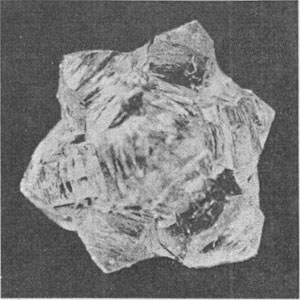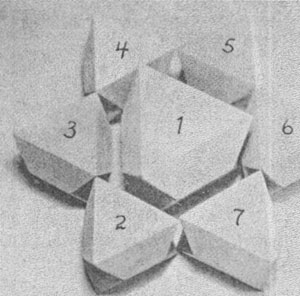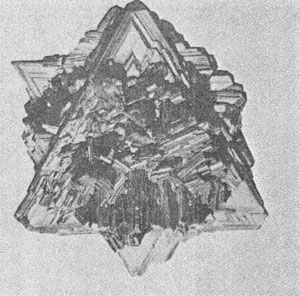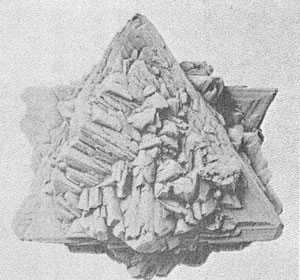| Home | AmMin | GMR | RiMG | Collectors Corner | Directory | Short Courses | |
|
|
|||||||

|
|
Volume 17, pages 360-361, 1932 MULTIPLE TWINS OF DIAMOND AND SPHALERITE CHARLES PALACHE Two twin groups in the Harvard Mineral Collection seem sufficiently different from any that have been described to be worthy of illustration. The diamond multiple twin (No. 90303) is from South Africa. It is shown in fig. 1, from a photograph, with enlargement of about 6 diameters. The specimen is water white, weighs 1.8 carats and measures 8 mm. in greatest diameter and 5 mm. in thickness. The photograph is not sharp in the middle field so the actual appearance of the object is not brought out. It is wheel-like, the six spokes or teeth surrounding a central hub which projects about 2 mm. above and below the general plane of the wheel. The central crystal, like all the "radiating" ones, is seen in the direction of a trigonal axis and each is twinned about this axis or on the "spinel law." Any twin-pair is a much rounded dodecahedron much like figure 352 in Goldschmidt, Atlas der Kryst., Vol. 3, Tafel 47, which is from Fersmann & Goldschmidt, Diamant, 1911, Plate 36, fig. 244. The faces are much too rounded to permit of ordinary crystal measurement, but the general character of the crystal form is unmistakable. In order to explain diagrammatically the relations of the members of the group, there are shown in figure 2, models of seven spinel-twinned octahedrons grouped as it is quite certain the members of the diamond twin-aggregate are grouped. The central, model (hub of the diamond wheel) No. 1 is parallel to numbers 2, 4, and 6. Nos. 3, 5, and 7 are parallel to each other but in twin relation to No. 1. Or we can say that the upper half of 1 is twinned to the lower halves of 2, 4, and 6 and the upper halves of 3, 5, and 7 while the lower half of 1 is twinned to the upper parts of 2, 4, and 6 and the bottoms of 3, 5, and 7. The spokes are evidently in twin position to next neighbors. Either two individuals or fourteen are then involved in this multiple twin, depending upon the point of view regarding such intergrowths of the individual observer. The sphalerite twin (No. 91613) came to the Harvard Museum many years ago from the Cashier Mine near Breckenridge, Colorado. It is a tetrahedron of black color and good lustre, 3 cm. on an edge, with all four faces of the tetrahedron showing in whole or in large part. A view of this specimen is shown in fig. 3, which is from a photograph looking directly down on a tetrahedron face. Besides the dominant tetrahedron which may be regarded as the positive one there are small but very bright faces of the negative tetrahedron and faint lines of the cube on the long edges.
In the figure it is clear that the tetrahedron face with the base of its triangle horizontal is in twin position to the similar face visible only in its points; and that this twinning is about a trigonal axis. At the same time one can see on the tetrahedron face three groups of parallel ridges dipping down towards the centre of the aggregate. They are shown best, especially the least developed set, on fig. 4. These ridges are the cube edges of three sets of intergrown tetrahedrons, each of which bears to one of the remaining three faces of the tetrahedron the same twin relation as shown for one pair in the photograph. In other words this is a fiveling, with four crystals or groups of parallel crystals twinned about each of the four trigonal axes of the primitive tetrahedron. The individual sets of crystals are closely parallel as is shown by the almost simultaneous reflections from the bright negative tetrahedron faces when the face is turned to the right position. Each tetrahedron face of the "central" or primative tetrahedron shows the same characters as above described for the face shown in the photograph. I am indebted to Dr. W. T. Schaller for the excellent photographs shown here of the unusual twin group.
|



